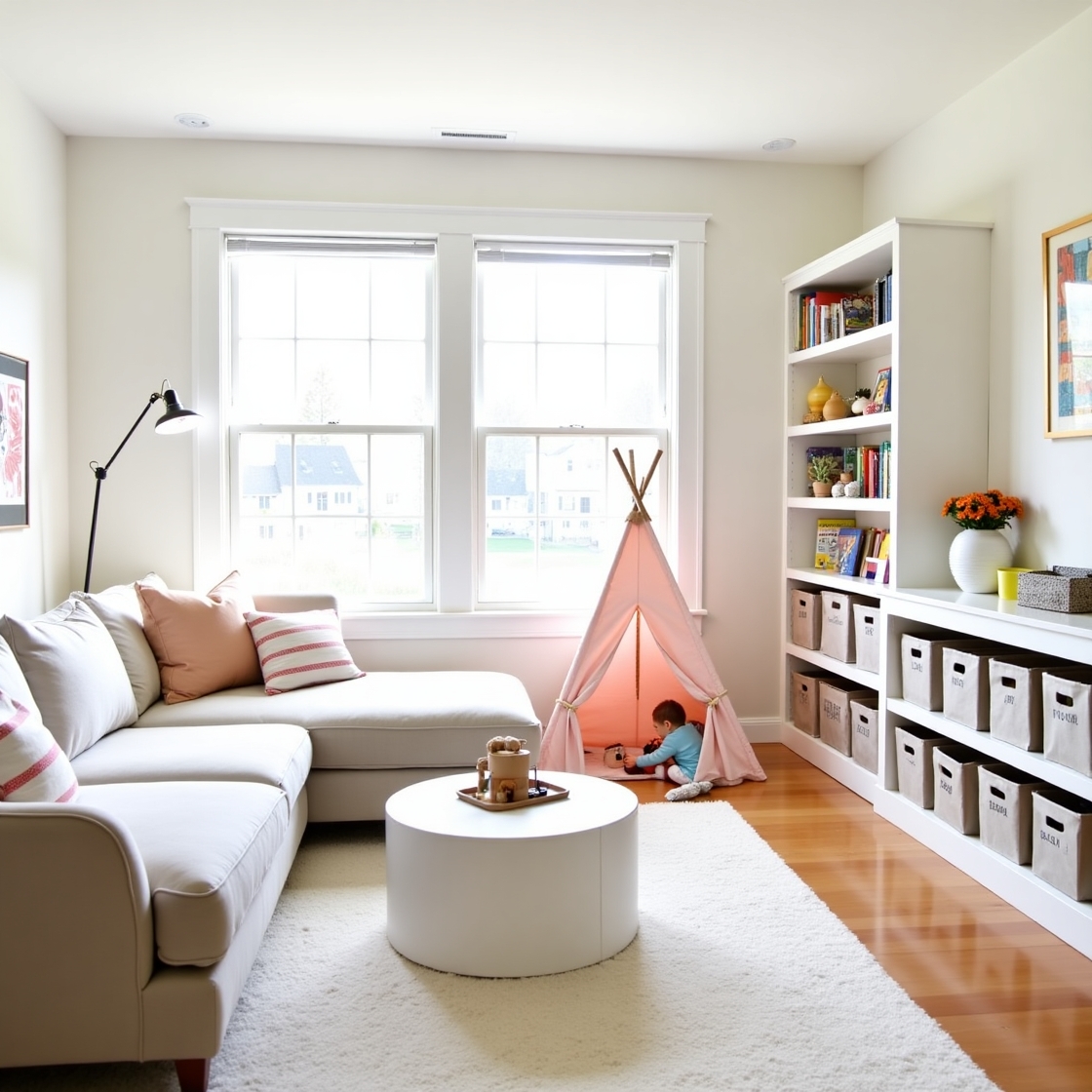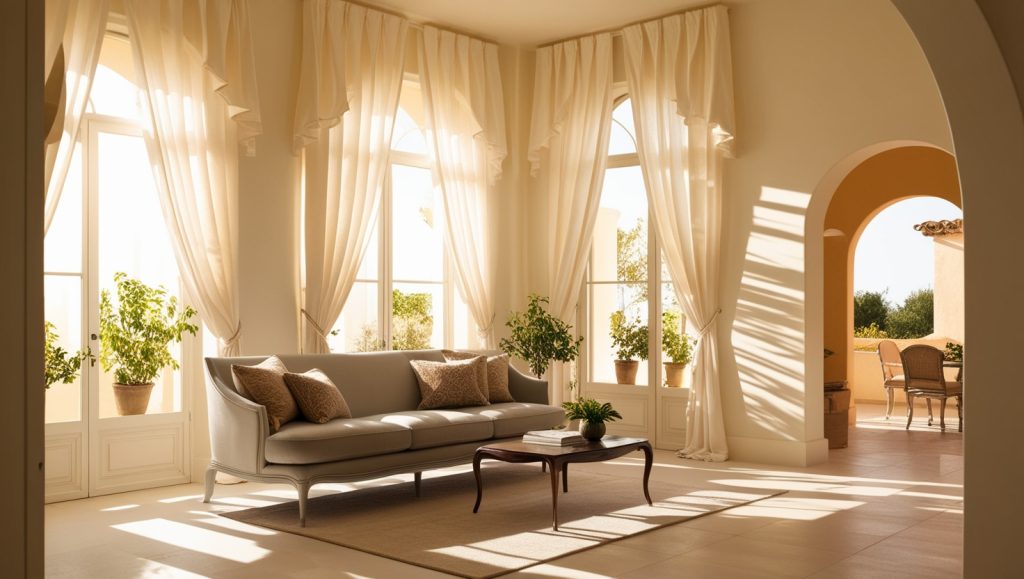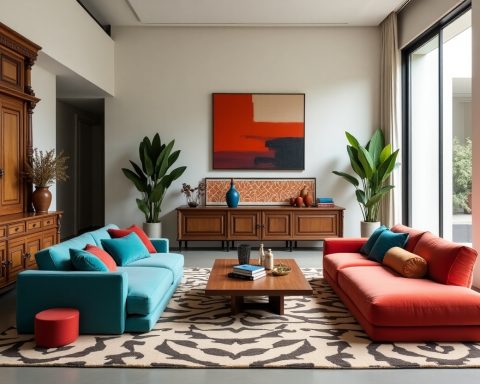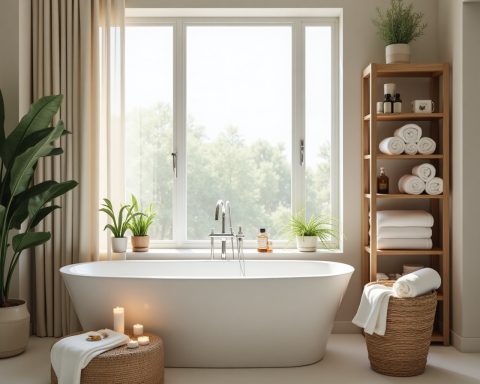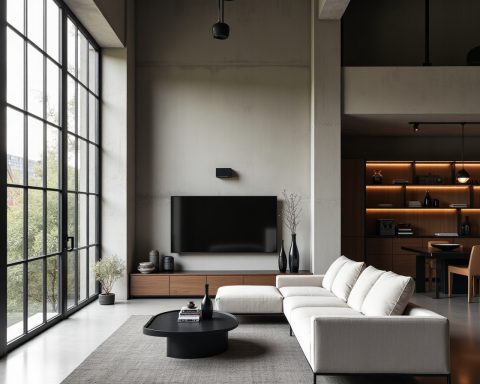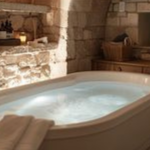Designing a living space that gracefully accommodates the vibrant energy of children while maintaining an aesthetically pleasing and sophisticated environment for adults is a common aspiration for many families. The notion that kid-friendly design necessitates a sacrifice of style is a misconception. In reality, a well-thought-out approach can seamlessly integrate practicality and elegance, resulting in a home that is both visually appealing and perfectly suited to the needs of all its inhabitants. This comprehensive guide delves into the nuances of achieving this harmonious balance, offering insightful tips and actionable strategies to transform your living space into a haven of style and functionality for everyone.
Here are 25+ In-Depth and Informative Ways to Design a Kid-Friendly Yet Stylish Living Space:
1. Selecting Robust and Easily Maintainable Fabrics: The Foundation of Durability
The choice of upholstery fabrics is paramount in a home with children. Opting for materials that can withstand the rigors of daily life and are easily cleaned is crucial for longevity and maintaining a presentable space.
- Prioritize Performance Fabrics: These are specifically engineered to resist stains, repel liquids, and endure heavy use. Microfiber, known for its soft texture and resilience; canvas, valued for its durability and washability; denim, offering a casual yet sturdy option; and treated blends, which often incorporate stain-resistant finishes, are excellent choices. Research the Martindale rub count of fabrics to gauge their abrasion resistance – a higher count indicates greater durability.
- The Practicality of Washable Slipcovers: Investing in furniture with removable and washable slipcovers offers unparalleled convenience. When spills or marks occur, the covers can be easily taken off and laundered, preserving the appearance of your furniture without the need for professional cleaning. Consider natural fabrics like cotton or linen blends for slipcovers, ensuring they are pre-shrunk for easy care.
- Strategic Rug Choices: Flooring in a kid-friendly space needs to be both comfortable and easy to clean. Natural fiber rugs like jute and sisal, while offering a stylishly textured look, are surprisingly durable and relatively easy to maintain with regular vacuuming. Low-pile synthetic rugs, such as those made from polypropylene or nylon, are highly stain-resistant and can often be spot-cleaned effectively. Avoid high-pile or delicate rugs that can trap dirt and are difficult to clean. Consider modular rug tiles that allow for easy replacement of damaged sections.
2. Embracing Multi-Functional Furniture: Maximizing Utility and Space Efficiency
In a home where space might be at a premium, furniture that cleverly serves multiple purposes is an invaluable asset.
- Storage Ottomans: Style Meets Practicality: An ottoman with a hinged or lift-off lid provides comfortable seating or a footrest while offering hidden storage for toys, blankets, magazines, or even extra pillows. Choose ottomans in durable fabrics that complement your décor.
- Transformative Coffee Tables: Opt for coffee tables featuring built-in drawers, open shelving underneath, or a lift-top mechanism. Drawers can discreetly house remote controls, board games, or art supplies, while a lift-top can create a comfortable surface for homework or casual dining.
- The Versatility of Sofa Beds: A stylish sofa bed offers comfortable seating during the day and can easily transform into an extra bed for overnight guests or create a temporary play area for imaginative scenarios. Look for sofa beds with durable frames and easy-to-operate mechanisms.
3. Implementing Smart and Accessible Storage Solutions: Cultivating Order and Independence
Effective storage is the cornerstone of a stylish yet kid-friendly living space. Making storage accessible to children encourages them to participate in tidying up.
- Stylish Baskets and Bins: Aesthetic Organization: Utilize attractive baskets and bins made from materials like woven fibers, canvas, or durable plastic to organize toys, books, and craft supplies on shelves and within cabinets. Labeling bins with words or pictures helps children identify where their belongings belong.
- Low and Open Shelving: Promoting Accessibility: Choose low shelving units with open access that allow children to easily see and reach their toys and books. This encourages independence in choosing activities and putting things away. Ensure shelves are securely anchored to the wall.
- Integrated Storage Furniture: Seamless Organization: Select furniture pieces with built-in storage, such as benches with drawers beneath seating, entertainment centers with enclosed cabinets, or even bed frames with under-bed storage drawers. This seamlessly integrates storage into the design.
4. Strategically Defining Play Zones Without Physical Barriers: Flexible Spatial Arrangement
Creating dedicated areas for play without making the living space feel fragmented is key to maintaining an open and stylish flow.
- The Visual Definition of Area Rugs: Employ large, visually distinct area rugs to delineate play zones from seating or dining areas within an open-plan living space. Choose rugs with playful patterns or colors that appeal to children while still complementing the overall aesthetic.
- Furniture Arrangement as Natural Dividers: Position sofas, armchairs, and shelving units to naturally create boundaries between different functional zones. For example, the back of a sofa can subtly separate a play area from the main seating area.
- Stylish Playmats: Combining Comfort and Design: Opt for large, cushioned playmats with stylish patterns or subtle designs that provide a comfortable and safe surface for play while blending seamlessly with your décor. Reversible playmats offer versatility.
5. Prioritizing Rounded Edges and Child-Safe Furniture: Ensuring Safety and Softening Lines
Minimizing sharp edges and ensuring furniture stability is crucial for a safe environment for children.
- Rounded Coffee and Side Tables: Mitigating Bumps: Choose coffee tables and side tables with smooth, rounded corners or consider softer alternatives like ottomans or upholstered cubes.
- Soft Ottomans and Poufs: Versatile and Safe Seating: Ottomans and poufs offer flexible seating options and footrests without the sharp edges of traditional furniture. Select durable and easy-to-clean upholstery.
- Anchoring Furniture: Preventing Tip-Overs: Secure all tall or potentially unstable furniture, such as bookshelves, dressers, and entertainment units, to the wall using appropriate anchoring hardware. This is a critical safety measure.
6. Selecting Washable and Non-Toxic Paint: Protecting Walls and Well-being
The type of paint you choose impacts both the aesthetics and the health of your living space.
- Washable Paint Finishes: Easy Maintenance: Opt for paint finishes with a higher sheen, such as eggshell, satin, or semi-gloss, as these are more durable and easier to wipe clean of fingerprints, spills, and crayon marks.
- Low-VOC or VOC-Free Paints: Promoting Healthy Air Quality: Volatile Organic Compounds (VOCs) are chemicals released by some paints that can be harmful. Choosing low-VOC or VOC-free paints ensures better indoor air quality, which is particularly important for children.
7. Creating a Kid-Friendly Yet Stylish Gallery Wall: Celebrating Creativity and Personal Style
A gallery wall can be a dynamic way to showcase both your artistic taste and your children’s creativity.
- Cohesive Framing: Unifying the Display: Use simple, matching frames in materials like wood or metal to create a unified and sophisticated look for both professional artwork and children’s creations.
- Child-Friendly Hanging Height: Accessibility and Appreciation: Hang a portion of the gallery wall at a height that allows children to easily view and appreciate their own artwork.
- Rotating Artwork: Keeping Things Fresh and Engaging: Regularly rotate the artwork displayed to showcase your children’s latest masterpieces and keep the gallery wall visually dynamic. Consider using easily accessible display methods like clipboards or magnetic boards for frequently changing pieces.
8. Opting for Durable and Aesthetically Pleasing Flooring: Balancing Style and Resilience
Flooring in a kid-friendly living space needs to withstand heavy traffic, spills, and the general wear and tear of childhood.
- The Practicality of Hardwood and Laminate: Hardwood and laminate floors are durable, easy to clean with sweeping and mopping, and offer a stylish foundation for your décor. Consider engineered hardwood for added stability in humid environments.
- Durable Tile and Vinyl: Versatile and Easy Care: Tile and vinyl flooring options are highly resistant to scratches and water damage, making them ideal for high-traffic areas. Luxury vinyl plank (LVP) offers a stylish wood-look alternative with excellent durability.
- Strategic Rug Placement: Adding Softness and Defining Zones: Use rugs not only to define play areas but also to add softness underfoot and absorb sound. Choose rugs with patterns that can help camouflage minor spills.
9. Designating a Dedicated Creative Corner: Fostering Imagination and Containing Mess
Creating a specific area for artistic endeavors helps contain supplies and encourages creativity.
- A Child-Sized Table and Chairs: Comfortable Workspace: Provide a small table and chairs that are appropriately sized for children, creating a comfortable and dedicated workspace for drawing, painting, and crafting.
- Organized Art Supply Storage: Utilize a rolling cart with drawers or tiered storage bins to keep art supplies like crayons, markers, paper, and paint organized and easily accessible.
- Protective Floor Covering: Place a washable mat or a large piece of craft paper under the art area to protect your flooring from spills and paint splatters.
10. Choosing Window Treatments with Safety and Style in Mind: Balancing Light, Privacy, and Security
Window treatments should be both aesthetically pleasing and safe for children.
- Cordless Options: Eliminating Strangulation Hazards: Opt for cordless blinds, shades, or shutters to eliminate the risk of strangulation posed by dangling cords.
- Durable and Washable Curtains: Choose curtains or drapes made from durable and easy-to-wash fabrics like cotton or polyester blends. Consider blackout curtains for media rooms or for facilitating naps.
- Layering Treatments: Versatility and Style: Layer sheer curtains with heavier drapes or blinds to offer flexibility in light control and privacy while adding visual interest.
11. Personalizing with Kid-Friendly Yet Sophisticated Decor: Injecting Personality Without Clutter
Incorporate decorative elements that appeal to children’s interests without compromising the overall style of the space.
- Subtle Thematic Pillows and Throws: Choose throw pillows and blankets with subtle patterns, textures, or colors that hint at child-friendly themes (like animal prints or geometric shapes) without being overly cartoonish.
- Curated Toy and Book Displays: Select a few visually appealing toys or children’s books with attractive covers to display as decorative accents on shelves or coffee tables. Rotate these items to keep the space fresh.
- Sophisticated Interpretations of Childlike Themes: Incorporate maps, globes, or animal-themed artwork in a mature and stylish manner. For example, a vintage botanical print of animals or a beautifully illustrated world map.
12. Making Technology Integration Kid-Friendly: Safety and Organization
In today’s digital age, managing technology safely and stylishly is essential.
- Secure TV Mounting: Mount televisions securely to the wall to prevent them from being tipped over. Use appropriate mounting hardware and ensure it is installed correctly.
- Cord Concealment Solutions: Utilize cord concealers, cable management boxes, or furniture with built-in wire management to keep cords out of reach and minimize visual clutter.
- Durable Device Cases: Invest in sturdy and protective cases for tablets and other electronic devices used by children.
13. Embracing Open and Flexible Layouts: Promoting Interaction and Adaptability
An open floor plan facilitates interaction and allows for flexible use of the space.
- Clear Pathways: Facilitating Movement: Arrange furniture to create clear and unobstructed pathways throughout the living space, allowing children to move freely and safely.
- Minimizing Clutter: Creating a Sense of Spaciousness: Avoid overcrowding the room with excessive furniture or decorative items. A less cluttered space feels more open and is easier for children to navigate.
- Modular Furniture: Adaptability for Changing Needs: Consider modular furniture pieces, such as sectional sofas or stackable storage units, that can be easily reconfigured as your family’s needs evolve.
14. Incorporating Natural Elements: Bringing the Outdoors In Safely
Introducing natural elements can add warmth, texture, and visual interest to your living space.
- Resilient and Child-Safe Houseplants: Choose houseplants that are known to be non-toxic to children and pets, such as spider plants, Boston ferns, or prayer plants. Ensure they are placed in stable pots and out of reach of small children if necessary.
- Natural Materials in Decor: Incorporate natural materials like wood, cotton, linen, and wool in your furniture, textiles, and decorative accents to add warmth and tactile interest.
- Displaying Natural Finds Thoughtfully: Showcase interesting rocks, shells, or pieces of driftwood in a curated and stylish manner on shelves or coffee tables.
15. Creating a Cozy Reading Nook for All Ages: Fostering Literacy and Relaxation
A dedicated reading nook encourages a love of books and provides a comfortable space for relaxation.
- Comfortable Seating Options: Include a comfortable armchair, a plush beanbag chair, or a cozy floor cushion suitable for both adults and children.
- Adequate Lighting: Ensure the reading nook is well-lit with a floor lamp or a wall-mounted reading light.
- Accessible Book Storage: Keep a selection of age-appropriate books readily accessible on a small bookshelf or in a stylish basket.
16. Utilizing Vertical Space for Multifaceted Purposes: Maximizing Every Inch
When floor space is limited, maximizing vertical space is a smart design strategy.
- Floating Shelves: Display and Storage: Install floating shelves to display books, toys, decorative items, or even plants, freeing up valuable floor space. Ensure they are securely mounted.
- Tall, Narrow Storage Units: Space-Saving Organization: Opt for tall, narrow storage cabinets or étagères to provide ample storage without taking up too much floor area.
- Hooks for Organization: Install stylish hooks on walls for hanging backpacks, dress-up clothes, or even lightweight storage bags.
17. Choosing Stylish and Safe Lighting Options: Illuminating with Care
Lighting should enhance the ambiance while prioritizing safety, especially around children.
- Lamps with Sturdy Bases: Select table and floor lamps with stable bases that are less likely to be accidentally knocked over.
- Dimmable Lighting: Versatile Ambiance: Incorporate dimmer switches to adjust the light level according to the activity, creating a softer ambiance for relaxation or brighter light for playtime.
- Shatterproof Bulbs in Whimsical Lighting: If using string lights or other decorative lighting, opt for bulbs made from shatterproof materials for added safety.
18. Making Cleaning Supplies Easily Accessible (Yet Safely Stored): Promoting Quick Clean-Ups
Having cleaning supplies readily available makes it easier to tackle spills and messes promptly.
- Designated and Child-Proofed Storage: Keep a designated area for cleaning wipes, cloths, and a small handheld vacuum or dustpan and brush. Ensure this storage is child-proofed with latches or placed out of reach.
- Stylish Storage Caddies: Utilize attractive storage caddies to keep frequently used cleaning supplies organized and portable.
19. Involving Children in the Design Process (Age-Appropriately): Fostering Ownership and Pride
Giving children a voice in the design process, within reasonable limits, can make them feel more connected to the space.
- Color Choices for Personal Touches: Allow them to choose colors for their artwork displays or for small decorative items in their designated areas.
- Arranging Belongings: Let them help arrange their toys and books on their shelves, fostering a sense of ownership and responsibility.
- Input on Decorative Accents: Ask for their opinions on child-friendly decorative accents, such as the placement of a favorite stuffed animal or a piece of artwork.
20. Strategically Incorporating Color: Adding Vibrancy Without Overwhelm
While a neutral base can create a sophisticated backdrop, thoughtful pops of color can inject energy and fun.
- Colorful Textiles: Use vibrant throw pillows, blankets, or rugs to add splashes of color that can be easily changed as tastes evolve.
- Zoned Color Accents: Consider a colorful rug to define a play area or paint a single accent wall in a child-friendly hue while keeping the rest of the walls neutral.
- Art and Accessories: Introduce color through artwork, decorative accessories, and even plants with colorful foliage.
21. Creating a Functional “Landing Zone” for Belongings: Promoting Organization at the Entryway
A designated area near the entrance helps keep everyday items organized and prevents clutter from accumulating.
- Hooks and Benches: Install sturdy hooks for hanging backpacks, coats, and scarves. A small storage bench provides a place to sit and remove shoes while offering additional storage.
- Designated Trays and Baskets: Use attractive trays or baskets to collect keys, mail, and other small items that tend to accumulate near the door.
22. Embracing Imperfection and Prioritizing Flexibility: A Realistic Approach to Family Living
A home with children is a dynamic environment, and striving for constant perfection is often unrealistic.
- Focus on Functional Systems: Instead of aiming for flawless order, focus on creating organizational systems that are easy for everyone to follow, even if they aren’t always perfectly executed.
- Adaptability is Key: Be prepared to adapt your design as your children grow and their needs and interests change. What works for toddlers might not work for teenagers.
23. Prioritizing Comfort for All Family Members: Creating Inviting Spaces
Ensure that the living space offers comfortable seating and relaxation areas for both adults and children.
- Mix of Seating Heights and Styles: Include a combination of adult-sized sofas and armchairs along with smaller, kid-friendly seating options like beanbag chairs, floor cushions, or small armchairs.
- Soft and Inviting Textiles: Use soft throws, plush pillows, and comfortable rugs to create cozy and inviting spots for lounging and relaxation.
24. Choosing Decor That Sparks Imagination and Curiosity: Encouraging Exploration
Incorporate decorative elements that can engage children’s imaginations and foster a sense of wonder.
- Educational and Inspiring Decor: Consider a world map, a constellation chart, or artwork depicting animals or nature scenes.
- Displayed Collections: Showcase interesting collections of natural items, books, or small toys in an aesthetically pleasing way.
- Open-Ended Play Spaces: Leave some areas relatively open and uncluttered to encourage imaginative play and allow children to create their own scenarios.
25. Remembering Your Personal Style: Maintaining Adult Aesthetics
While prioritizing kid-friendliness is essential, your own style and preferences should still be reflected in the design.
- Durable Versions of Loved Styles: Choose durable and easy-to-clean versions of the colors, patterns, and styles you are drawn to.
- **Integrating Cherished Items
In Conclusion
Designing a living space that is both kid-friendly and stylish is not an unattainable ideal but rather a thoughtful process of balancing practicality with aesthetics. By prioritizing durable and easy-to-clean materials, embracing multi-functional furniture, implementing smart and accessible storage solutions, and focusing on safety, you can create a home that gracefully accommodates the needs of children without compromising adult style. The key lies in making intentional choices that cater to the realities of family life while still reflecting your personal taste and creating a visually appealing environment. Ultimately, a successful kid-friendly yet stylish living space is one where everyone in the family feels comfortable, inspired, and truly at home.
